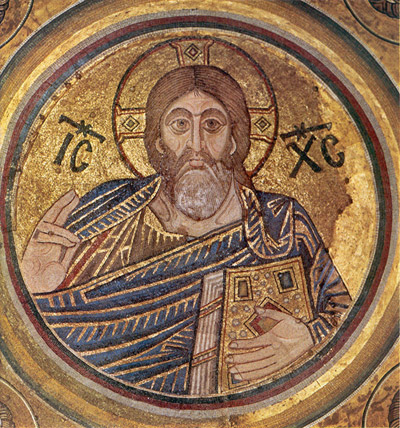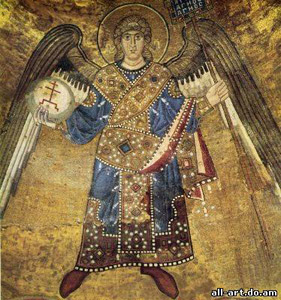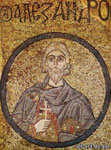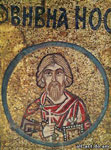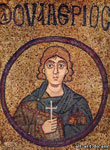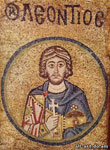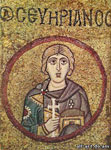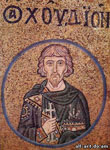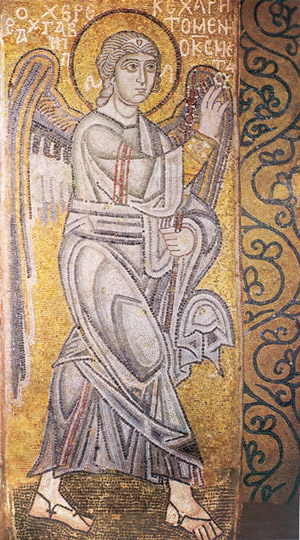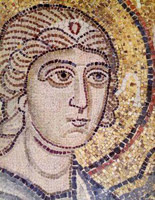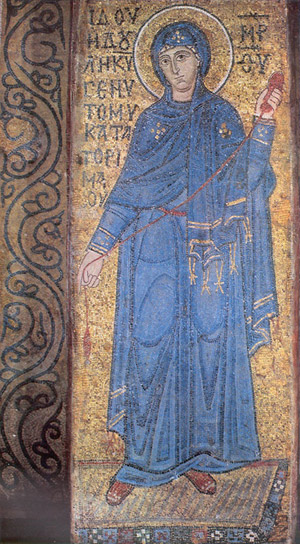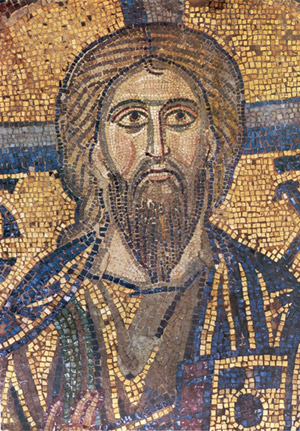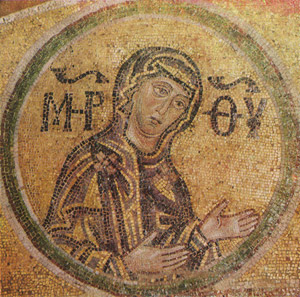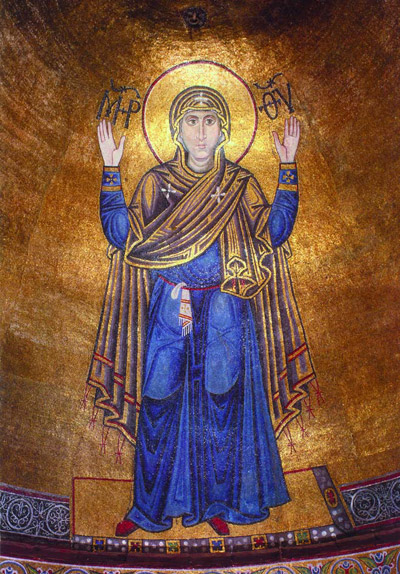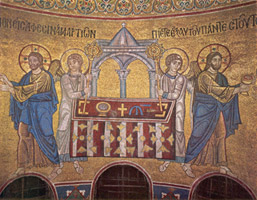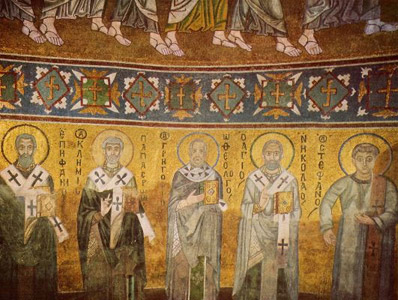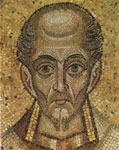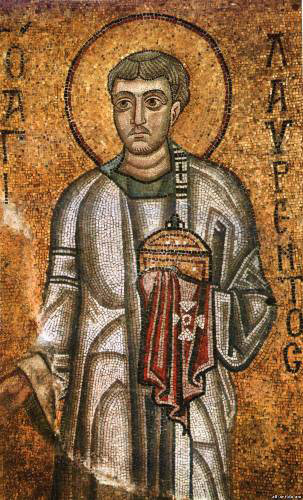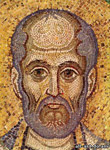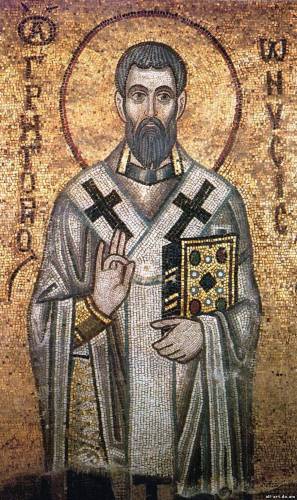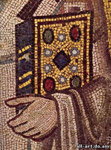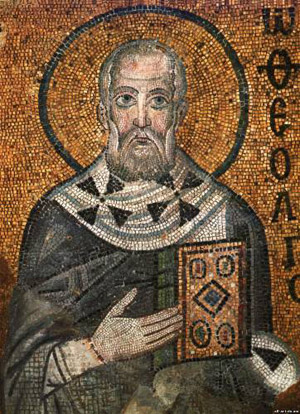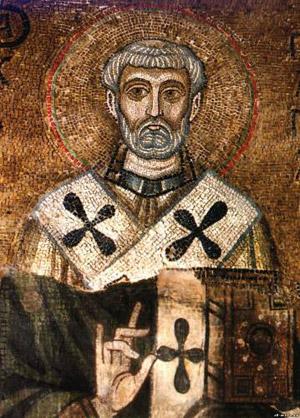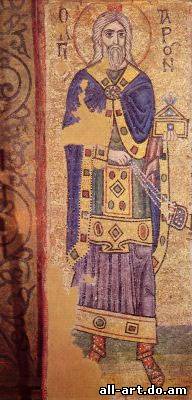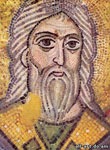ua. ru. en.
Museum ST. SOPHIA CATHEDRAL
Historical information
Plan of museum
ST. SOPHIA CATHEDRAL
Narthex
Architecture and murals
- Plan, Ground floor
- Mosaics
- Frescos
- Graffiti
- other details
Sarcophagus of Yaroslav the Wise
North cloister
Towers
Lofts
- Plan, First floor
ARCHITECTURAL MONUMENTS OF THE 18TH CENTURY
Bell Tower
Seminary
Cells of the Cathedral Elders
Metropolitan's Residence
Refectory
Consistory
South Entrance Tower
Zaborovsky Gate
First Rus library
BRANCHES OF THE MUSEUM
|
|
Excursions Kiev
weekend in Kiev
trip to Kiev
Excursions
tours to Kiev
Sights of Kiev
MOSAICS
Mosaics decorate the chancel and the central cupola.
Central cupola. Diagram showing mosaics arrangement:
Chancel. Diagram showing mosaics arrangement:
These images represent the main personages in the Christian religion and are arranged strictly according to "religious hierarchy" and correspond to the hierarchy of feudal society.
All the mosaics that survive are genuine relics of the 11th century. However, some mosaics having missing parts were filled in with oil painting in the 19th century.
At the top of the central cupola, and set in a medallion with a diameter of 4.1 metres, there Is a monumental half-length figure of Christ Pantocrator wearing a purple robe and a blue mantle.
Christ Pantocrator. Central cupola:
The medallion is framed by nine circles of different colours, reminiscent of a rainbow. The Christ Pantocrator is surrounded by four archangels: only the one arrayed in blue is still a mosaic, the three others were painted in oils by M. Vrubel in 1884.
Archangels. Details. Central cupola:
The twelve apostles are depicted in the spaces between the drum windows, but only the upper part of St. Paul's figure survives as a mosaic. The four evangelists are depicted on the pendentives supporting the cupola but only the image of St. Mark on the south-west pendentive survives in its original form. St. Mark is seated on a chair before an open book of the Gospel with a pen in his right hand and a scroll in his left. He wears a greyish-white robe and a pale violet mantle. Green, yellow and gold tesserae are also used, which greatly enhance the overall colour scheme.
Evangelist Mark. Detail. South-west pendentive:
"Evangelist John". Detail:
On the other evangelists mosaic images only small fragments preserved. Among them is a very interesting picture of the little table writing instruments on the southeastern sail (part song "The Evangelist Matthew").
"Evangelist Matthew". Detail. little table:
Sevastiysky martyrs in St. Sophia Cathedral in Kiev. Details. Mosaic.
Fifteen mosaic medallions portraying martyrs, still in good condition, are to be found on the intrados of the north and south wall arches under the central drum.
On the arch columns before the chancel, a mosaic depicts the scene of the Annunciation: the Archangel Gabriel is on the left, the Virgin Mary on the right.
| The Annunciation. Archangel Gabriel Arch column before the chancel: | Annunciation. The Virgin Mary. Arch column before the chancel: |
Both parts of the composition have a beautiful colour palette. Gabriel is arrayed in a white garment touched with pale green, crimson and black. The radiant white colour is emphasized by his red sandals, crozier and striped sleeves. Mary is in dark blue enlivened by gold on the sleeves and the ends of her hooded mantle. The Virgin's red shoes and the spindle of yarn she holds provide contrast to her dark-blue raiment.
Chancel of St. Sophia Cathedral
The Deesis on the arch over the central apse consists of three medallions depicting Jesus, the Virgin Mary, and John the Baptist.
The Deesis. Arch over the central apse:
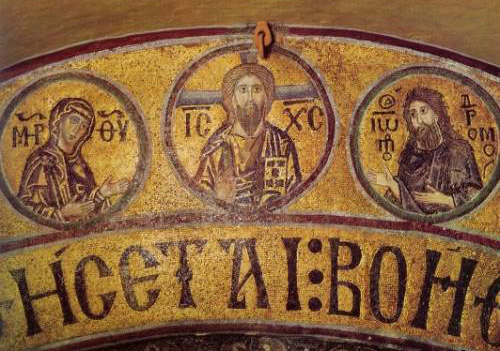
The Deesis. Detail. Jesus. Arch over the central apse:
The Deesis. Detail. The Virgin Mary. Arch over the central apse:
The Deesis. Detail. John the Bartist. Arch over the central apse:
The Virgin Orans. Chancel of St. Sophia Cathedral
On the concha is the gigantic mosaic of the Virgin Orans, the madonna in prayer. It dominates all the murals within the cathedral's interior, and is about six metres high. The Virgin stands with raised hands on a broad platform ornamented with precious stones. Mary wears a dark blue robe and a crimson mantle whose folds are edged with gold. Her shoes are red. A startling white fringed kerchief is draped over the red girdle round her waist. This mosaic of the Virgin Orans is full of grandeur, of unique monumental form and rich colouring.
The Virgin Orans. Chancel:
The Eucharist (Holy Communion) in St. Sophia Cathedral
Below the Orans is a wide panoramic composition of the Eucharist - a symbolic scene of the apostles partaking of the Blessed Sacrament. Angels with large fans stand on either side of the Communion table. To their left and right is the twice portrayed figure of Christ: on the left he is breaking bread with his disciples; on the right, he shares the wine. The disciples approach him from both sides, arrayed - as are the angels - in light-coloured robes; the figures of Christ are arrayed in an ultramarine mantle worn over a lilac robe touched with glittering gold. The scarlet Communion table in the centre makes the whole composition particularly impressive.
The Eucharist. Chancel:
The Eucharist. Details:
The Eucharist. Detail: Christ; Detail: Angel:
The Eucharist. Details:




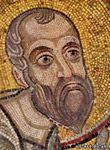
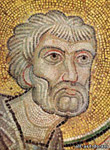
|


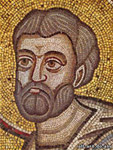



|
Eucharist - One of the main sacraments in which bread and wine mystically transubstantiated into the body and blood of Christ. Celebration of the Eucharist is the essence of the main Christian worship - the liturgy. At the Communion the faithful, partaking of bread and wine, which embodies "the true body" and "True Blood" Savior, joined with him and become a pledge of eternal life.
Composition "the Eucharist" includes the figure of Jesus Christ (often it is written twice) in the center of the composition and Apostles coming to him for Communion. Apostles headed by Peter and Paul. Christ stands before the throne and gives to his disciples bread and wine. The angels serve him. In the Cathedral the image "the Eucharist" is traditionally placed at the altar in the central apse. For this plot specially fixed place where the mystery of the liturgy, because it clearly explains what was going on worship.
Image of the Apostles who who receive Holy Communion has beenis widely used in X-XI centuries. The Sophia's "Eucharist" has presented extensive iconography of this subject.
Most successful color combinations in a double-repeated figure of Christ, dressed in a purple robe with gold assists and a light blue cloak - his clothes contrast with the gold background.
From both sides approach apostles. They hardly recognizable due to differences in the canon form. Their images are inexpressive and lacking individual identity, which distinguishes the Church Fathers on "Svyatitelskom rank", located here register below. Three of the Apostles at the left in Sofia's "Eucharist" is extremely difficult for attribution. Researchers still do not know who they are. Two figures, the extreme right, have not preserved - during one of the restorations in the 19th century they were written by paints. Presumably, this is the Apostles Bartholomew and Thomas.
"The Eucharist" the most archaic of all the mosaics of St. Sophia. Figures of the Apostles proportionally shorter, with larger heads, and stiffness in his movements, they postures and gestures are monotonous.
Church Fathers Range. Mosaic in St. Sophia Cathedral in Kiev
The mosaics in the lower row of the apse depict the Church Fathers Range (only the upper part of the figures survives as mosaics). The exquisite delineation of form, the rich and variegated colour range, and the integrity and finished perfection of the composition make this Range one of the most superb examples of old Rus monumental art. The faces are given individual and psychological traits. Especially expressive is the head of St. John Chrysostom (in the right part of the composition).
Fathers of the Church Range. Fragmentè. Chancel:
Fathers of the Church Range. Fragment. John Chrysostom. Chancel:
Fathers of the Church Range. Fragment. St. Basil the Great. 1th century. Chancel:
Fathers of the Church Range. Fragment. St. Laurentlus. Chancel:
Fathers of the Church Range. Fragment. St. Gregory Wonderworker. Chancel:
Fathers of the Church Range. Fragment. St. Gregory of Nyssa. Chancel:
Fathers of the Church Range. Fragment. St. Gregory the Theologian. Chancel:
Fathers of the Church Range. Fragment. St. Clement Pope. Chancel:
Fathers of the Church Range. Fragment. St. Epyfaniy. Chancel:
Other masaics in St. Sophia Cathedral in Kiev
Aaron. 11th century masaic. Chancel:
Christ the Priest:
The Apostle Paul:
Ornamentations. Chancel:
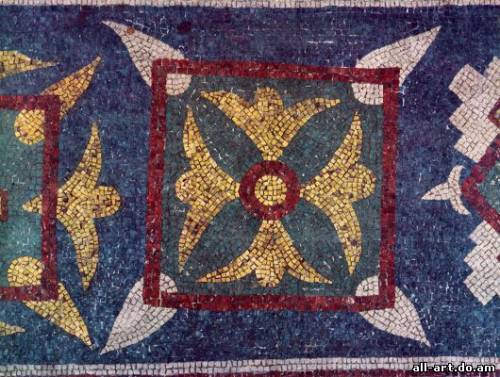
All the mosaics in the cathedral are depicted against glittering gold backgrounds.
They are remarkable for their richness, vivid colouring and pure tones. The predominant colours in the wide range of prismatic mosaics are dark blue and off-white combined with crimson. Each colour is represented by a great many tints and shades: 21 are blue, 34 are green, 19 are a rose-red, 25 are various tints of gold, and so on. This testifies to the high development of glass-making in Old Rus and of techniques in preparing tesserae. In all, the colour palette of the mosaics comprises 177 different hues or tints. The tesserae were made of glass, coloured with the aid of salts and oxidized metal additives. The picture or mosaic image was applied directly upon the wall by embedding the tesserae in wet plaster. On an average, the cubes were about one cubic centimetre in size. In the depiction of the faces, however, one often finds smaller cubes, about 0.25 cu. cm. The groundwork under the mosaics consisted of three layers having a total thickness of 4 to 6 centimetres. Besides the glass tesserae, cubes of natural stone were also used.
Each mosaic composition was surrounded by inscriptions in Greek to explain the subject. The names of the mosaic artisans are unknown. However, by studying the artistic feature of executing the separate images and the methods of applying the tesserae, we can determine a probable group of artisans numbering eight, not counting their apprentices.
During the restoration work in the St. Sophia Cathedral the mosaics were cleaned of accumulated dirt and soot and re-set in new plaster in places where the old tesserae had fallen out. The mosaics of the central cupola and the curving surface of the main apse all harmonize with the fresco painting.
Read more:
- FRESCOS >>>
- GRAFFITI >>>
- Other Details of the interior of the St. Sophia Cathedral >>>
 Mosaics and frescoes of St. Sophia Cathedral IN KIEV
Mosaics and frescoes of St. Sophia Cathedral IN KIEV
Virtual tour around the museum’s grounds of Saint Sophia Cathedral
National Historical Reserve "St. Sophia Cathedral in Kiev"
Address: Vladimirskaya Str. 24, Kiev Ukraine
Underground station "Golden Gate".
Hours: 10:00 - 17.30
Closed: Thursday


